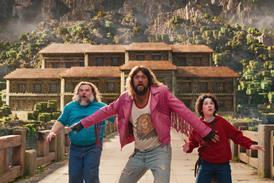The Slamdance festival director and co-founder talks about hot titles at the 2012 festival and the event’s growing digital presence year-round.
Seventeen years ago Peter Baxter and three other filmmakers – Dan Mirvish, Shane Kuhn and Jon Fitzgerald – launched Slamdance to create a showcase for independent filmmakers who couldn’t get into Sundance and wanted audiences to discover their work.
In the intervening years, Slamdance has grown into a hip Park City event that has spawned such renowned features as Paranormal Activity, Christopher Nolan’s first feature Following and the cult documentary The King Of Kong.
This year the festival screens about 100 films including 25 features in narrative competition, documentary competition and a special screenings category. Baxter also produced the short film Harold’s Bad Day and directed the Shrovetide football doc Wild In The Streets – both of which screen this year. Slamdance runs in Park City from Jan 20-26.
Slamdance has become a bit of a superhero for the indie community. Give us the origins story.
In 1995, a bunch of filmmakers were rejected from Sundance and we decided we would come together as a collaborative and show out films at Slamdance. At that time if you didn’t get your films into Sundance there were few places in the US where you could showcase your work. Sundance was beginning to show films that had US distribution, so for us it was very difficult to compete with that. In the first year we worked closely together and thought people were taking notice. My film Loser [Baxter produced it] got distribution and we decided we should continue Slamdance for filmmakers like us. Dan’s [Mirvish] film Omaha: The Movie also found distribution. That’s that we have been doing ever since. We have become more organised and we now receive a lot more submissions – in the first year we got 48 and this year we were over 5,000 submissions.
How have things changed at the festival?
In many ways we have lower-budget films than when we started because advances in technology have helped filmmakers make films [for less]. Some things have changed but a lot has stayed the same. The festival is still programmed by active filmmakers who have been at Slamdance before and they help engender the community here. It provides a lot of energy and allows people to see truly independent films coming out of nowhere. We are not influenced by agents, managers, etc. I don’t come in with a secondary group of programmers and change things.
So why submit your film to Slamdance?
As we get bigger, more and more filmmakers are not submitting to both festivals [Sundance and Slamdance]. A lot younger filmmakers realise that the type of films that became popular at Sundance are a tough fit for us and what you see at Slamdance is the promise of the underground. Bindlestiffs is an example of that. When the filmmakers made it they were both in high school and they will be 19 and 20 when they premiere it at the festival. This is what Slamdance is about – a good reputation of independent film.
We hear that, among others, OK, Good and Welcome To Pine Hill are ones to watch, plus Bindlestiffs. It sounds like there’s ‘vintage year’ potential.
The documentary competition is very strong. Docs have been very strong at Slamdance over the past couple of years. Superheroes was here last year and was picked up by HBO. In some ways the narrative features have been in the shadow of the docs, but this year there’s a very strong narrative competition and one of the reasons is it’s full of very strong direction. It’s exciting. Besides the great job the programmers have done, I think this is so because as the world faces many challenges, these challenges provide great inspiration to all independent filmmakers and you are seeing that in both our competitions.
Also, and this speaks to the narrative competition especially because of how cameras have developed over the last three to five years, and post-production software means you have a great looking production that you can make in your home space, so the storytellers have been able to send more time with the performances. The performances are a stand-out in many of these films.
OK, let’s get down to brass tacks. Do Slamdance and Sundance coexist peacefully?
When we first began there was a very strong sense that people thought, ‘There goes the neighbourhood.’ But as independent film has grown in the US, what has emerged has been very positive. Sundance and Slamdance make for a more vibrant scene where you have these festivals side-by-side. One is mature and shows great films and many of them have got big budgets, but if you look at Slamdance you see the promise of new filmmakers coming up. Together it makes for a strong independent showcase. It should not be viewed as a competition. When a Slamdance alumnus makes their next film and it gets into Sundance, that’s great. But what you get from Slamdance is a very focused programme for filmmakers.
Any distribution initiatives in the offing?
This has been development at Slamdance over the last three years. We launched three festivals ago a deal with Microsoft where we showcased films in completion on Zune and X-Box. Slamdance is developing a year-round business on several platforms which we will launch in 2012. As Microsoft says, we have a brand which we can exploit all year. We are growing a virtual presence. We will be bringing Slamdance films to an audiences that cannot make it to the festival.






















No comments yet